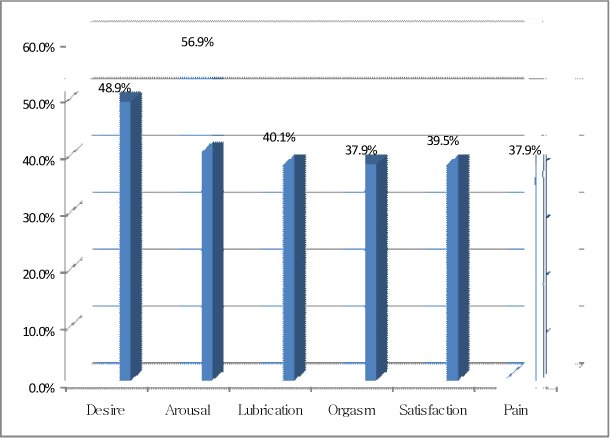J Korean Acad Psychiatr Ment Health Nurs.
2010 Sep;19(3):329-338. 10.12934/jkpmhn.2010.19.3.329.
Sexual Dysfunction and Related Factors in Married Korean Women
- Affiliations
-
- 1Department of Nursing, Gwangju Women's University, Korea.
- 2Department of Nursing, Chunnam Techno College, Korea. eslee@chunnam-c.ac.kr
- KMID: 2321846
- DOI: http://doi.org/10.12934/jkpmhn.2010.19.3.329
Abstract
- PURPOSE
This study was conducted to explore prevalence of sexual dysfunction and to determine factors influencing sexual dysfunction in married women.
METHODS
The participants were 372 married women in age 20~59 years. Data were collected through self-report questionnaires which were constructed to include general characteristics items (sociodemographic, health-related, and gynecological characteristics) and the FSFI (Female Sexual Function Index).
RESULTS
The mean total FSFI score was 20.6 while the proportion of women with female sexual dysfunction based on FSFI overall scores of 25.0 or less was 57.5%. Sexual dysfunctions were detected as desire problems (48.9%), arousal problems (56.9%), lubrication problems (40.1%), orgasm problems (37.9%), satisfaction problems (39.5%), and pain problems (37.9%). The sexual function of married women was significantly different according to age, job, duration of marriage, education, religion, monthly income, chronic disease, menopausal status, frequencies of delivery and pregnancy. Significant predictors influencing sexual function in married women were post-menopausal state, frequencies of delivery, chronic disease, and peri-menopausal state, and these predictors account for 29% of the variance in sexual dysfunction.
CONCLUSION
The results indicate a high prevalence of sexual dysfunction in married women which is comparable with results reported worldwide. Nurses need to be trained and prepared to address this issue.
Keyword
MeSH Terms
Figure
Cited by 2 articles
-
Influence of pregnant couples' attitudes towards sex during pregnancy on sexual function
Moon Jeong Kim
Korean J Women Health Nurs. 2020;26(2):161-170. doi: 10.4069/kjwhn.2020.06.18.1.Factors Influencing Sexual Function in Postmenopausal Married Women
Hye Young Kim, Eun Ko
Korean J Women Health Nurs. 2016;22(4):287-296. doi: 10.4069/kjwhn.2016.22.4.287.
Reference
-
1. Bae J. A study on female sexual dysfunction, marital accommodation, depression and crisis in Korean women. J Korean Acad Psychiatr Ment Health Nurs. 2004; 13(4):467–475.2. Basson R, Berman J, Burnett A, Derogatis L, Ferguson D, Fourcroy J, et al. Report of the international consensus development conference on female sexual dysfunction: Definition and classification. J Urol. 2000; 163:888–893.
Article3. Hayes RD, Dennerstein L, Bennett CM, Sidat M, Gurrin LC, Fairley CK. Risk factors for female sexual dysfunction in the general population: Exploring factors associated with low sexual function and sexual distress. J Sex Med. 2008; 5:1681–1693.
Article4. Hayes R, Dennerstein L. The impact of aging on sexual function and sexual dysfunction in women: A review of population based studies. J Sex Med. 2005; 2:317–330.
Article5. Kim HE, Jo YR, Park HS. Association between obesity, abdominal obesity and sexual dysfunction among Korean women. Korean J Obes. 2007; 16(4):170–176.6. Kim HY, So HS, Chae MJ, Kim KM. Comparisons of quality of life, sexual function, and depression in sexually active or inactive groups of women with mastectomy. J Korean Oncol Nurs. 2008; 8(2):77–85.7. Kim HY, So HS, Park KS, Jeong SJ, Lee JY, Ryu SB. Development of the Korean-version of Female Sexual Function Index (FSFI). Korean J Androl. 2002; 20(1):50–56.8. Kinsey AC, Pomeroy WB, Martin CE, Gebhard PH. Sexual behavior in the human female. Philadelphia: W.B. Saunders Company;1953.9. Korea National Statistical Office. Estimated population of women. 2008. Retrieved July 8, 2008. from http://kosis.kr/nsportal/wnsearch/totalSearch.jsp.10. Laumann EO, Paik A, Rosen RC. Sexual dysfunction in the United State: Prevalence and predictors. JAMA. 1999; 281:537–544.11. Lee YS. The relationship between marital conflict factors and sexual dissatisfaction of Korean urban wives. Seoul: Soongsil University of Korea;1989. Unpublished doctoral dissertation.12. Lutfey KE, Link CL, Rosen RC, Wiegel M, McKinlay JB. Prevalence and correlates of sexual activity and function in women: Results from the Boston area community health (BACH) survey. Arch Sex Behav. 2009; 38(4):514–527.
Article13. Nappi RE, Lachowsky M. Menopause and sexuality: Prevalence of symptoms and impact on quality of life. Maturitas. 2009; 63(2):138–141.
Article14. Park HS, Koo YH, Won HS. Sexual function and satisfaction with life in women and their predictors. J Korean Acad Psychiatr Ment Health Nurs. 2004; 13(4):505–513.15. Ponholzer A, Roehlich M, Racz U, Temml C, Ladersbacher S. Female sexual dysfunction in a health Austrian cohort: Prevalence and risk factors. Eur Urol. 2005; 47(3):366–374.16. Rosen R, Brown C, Heiman S, Leiblum S, Meston C, Shabsigh R, et al. The Female Sexual Function Index (FSFI): A multidimensional self-report instrument for the assesment of female sexual function. J Sex Marital Ther. 2000; 26:191–208.17. Safarinejad MR. Female sexual dysfunction in a population-based study in Iran: Prevalence and associated risk factors. Int J Impot Res. 2006; 18(4):382–395.
Article18. Sohn IS. Female sexual dysfunction. Korean J Obstet Gynecol. 2006; 49(10):2043–2054.19. Song SH, Jeon H, Kim SW, Paick JS, Son H. The prevalence and risk factors of female sexual dysfunction in young Korean women: An internet-based survey. J Sex Med. 2008; 5:1694–1701.
Article20. Wiegel M, Meston C, Rosen R. The Female Sexual Function Index (FSFI): Cross-validation and development of clinical cutoff scores. J Sex Marital Ther. 2005; 31(1):1–20.
Article21. Yoon H, Chung WS, Hong JY, Park YY, You EH, Kim JH. Questionnaires based evaluation of sexual activity and sexual dysfunction in Korean women. Korean J Urol. 2001; 42:102–114.
- Full Text Links
- Actions
-
Cited
- CITED
-
- Close
- Share
- Similar articles
-
- A Study on Female Sexual Dysfunction, Sexual Distress, Sexual Attitude and Knowledge in Korean Women
- Development of Sexual Satisfaction Measurement Tool
- A Concept Analysis of Sexual Dysfunction in Women Diagnosed with Breast Cancer
- Comparisons of Depression, Marital Intimacy, Sexual Function and Quality of Life in Sexual Active or Inactive Groups of Post-menopausal Married Women
- Factors Influencing Sexual Function in Postmenopausal Married Women


